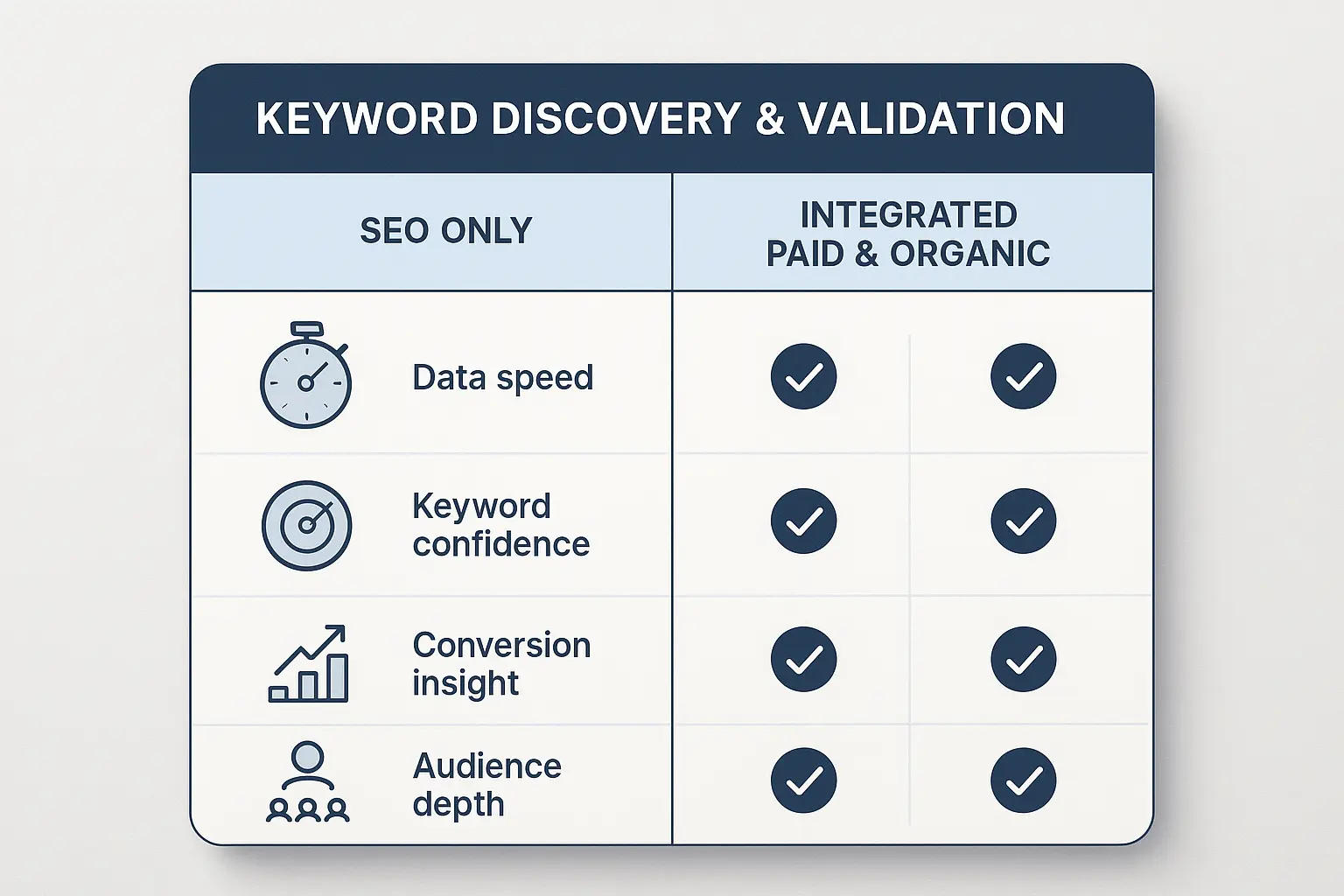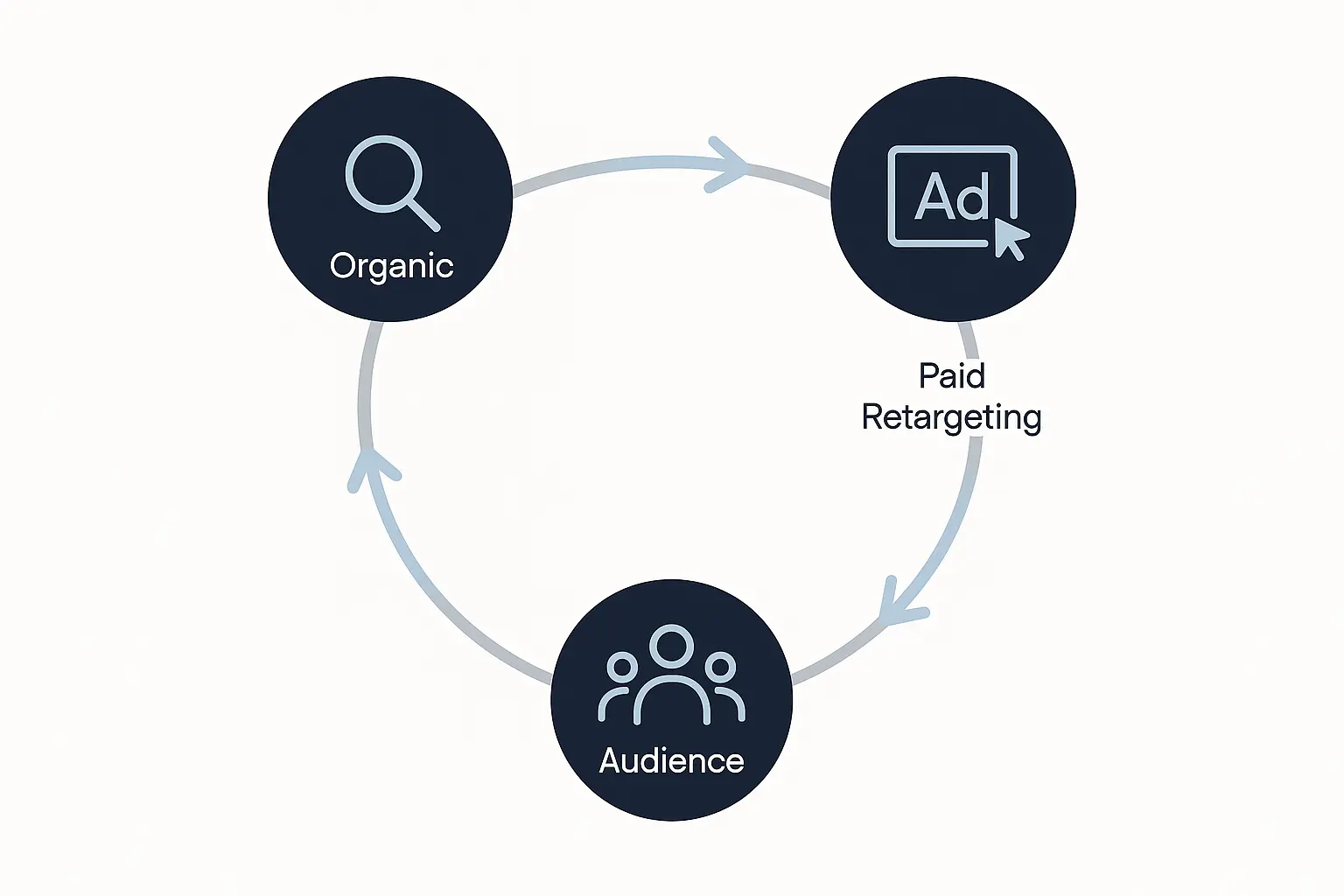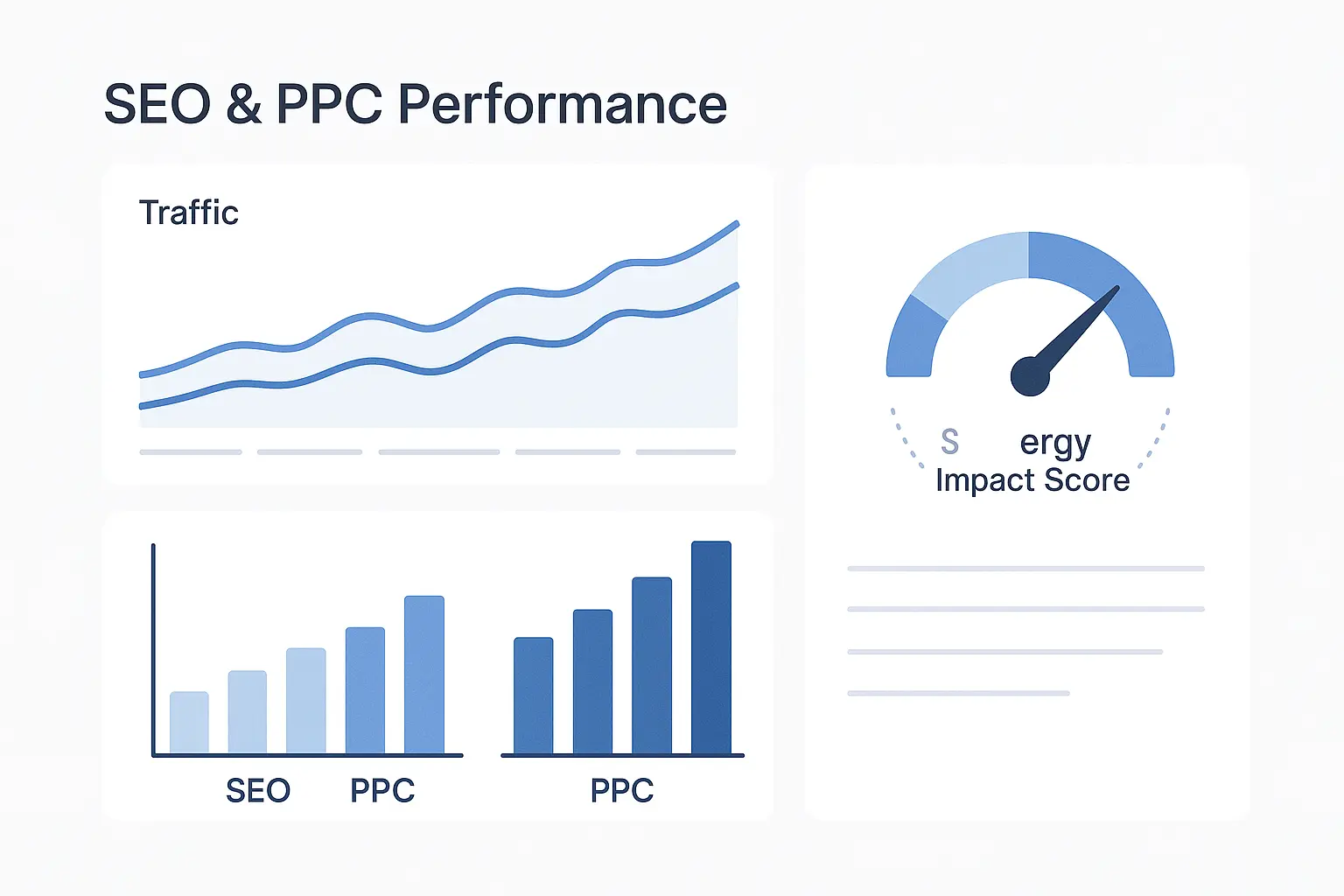The Paid & Organic Search Synergy Framework for Agencies
If you run an agency, you know the client memo: do more with less. Budgets are tight, but expectations for growth are higher than ever. In today’s climate, running paid search and SEO in separate lanes isn’t just inefficient—it’s a strategic failure. While competitors treat them as rivals competing for budget, top-performing agencies are building a unified growth engine.
These agencies understand that when managed correctly, paid and organic search create a powerful feedback loop. Data from one channel de-risks investment in the other, insights from paid campaigns sharpen SEO content, and together they dominate the search engine results page (SERP). In fact, research shows that SEO and PPC combined account for 65% of website traffic and more than half of conversions for major brands.
The question is no longer if you should integrate them, but how. This isn’t another high-level article about why they “work well together.” This is a practical framework for agencies ready to package, sell, and deliver an integrated search strategy that drives measurable client growth.
Why a Siloed Approach to SEO & PPC Is Costing Your Clients
For years, agencies have managed search in silos. The PPC team is immersed in Google Ads, obsessed with Quality Score and cost-per-acquisition, while the SEO team focuses on rankings and organic traffic from within Ahrefs and Google Search Console. They might share a report once a month, but their strategies rarely intersect in a meaningful way.
This disconnect leads to significant problems:
- Wasted Ad Spend: Campaigns bid on keywords that could be captured organically with the right SEO focus, driving up costs unnecessarily.
- Slow SEO Insights: SEO is a long game. It can take 6-9 months to know if a keyword strategy will pay off. Without real-world data, you’re making expensive bets based on historical volume and competitor analysis alone.
- Fragmented User Experience: A potential customer might see a paid ad with one message and then click an organic link with a completely different one, leading to confusion and lower conversion rates.
- Missed Opportunities: You lack visibility into the complete customer journey. You don’t know which organic blog post created the initial awareness that leads to a branded paid search and conversion later on.
This siloed approach leaves value on the table and makes proving holistic ROI much harder. The Synergy Framework is designed to close these gaps.
The Core Components of the Synergy Framework
Instead of a collection of disconnected tactics, this framework is a structured, repeatable process for turning two channels into one cohesive system. It’s built on three core pillars that feed into each other.
- Shared Keyword & Audience Intelligence: Use paid search data to find proven, high-converting keywords and de-risk your long-term SEO investments.
- Cross-Channel Retargeting Workflows: Create sophisticated user journeys that guide prospects from organic discovery to paid conversion and back again.
- Unified Performance Measurement: Move beyond siloed reports to a single dashboard that measures the total business impact of your integrated search strategy.
Let’s break down the implementation of each pillar.
Pillar 1: Shared Keyword & Audience Intelligence – Using PPC Data to De-Risk SEO
SEO’s biggest challenge is the time lag between action and result. You can spend months creating content and building links for a target keyword, only to find it doesn’t convert. Paid search solves this problem by providing a real-time data laboratory.
PPC campaigns offer immediate feedback on which messages resonate, which headlines get clicks, and most importantly, which keywords drive sales. This intelligence is the key to building a data-validated SEO strategy and de-risking your efforts from day one.
Here’s how it works:
- Validate Keywords with Conversion Data: Run a broad discovery campaign in Google Ads for a new client or service. Within weeks, you’ll have a list of keywords with actual impression, click-through-rate (CTR), and conversion data. Use this list to prioritize your SEO content calendar, focusing on the terms proven to generate leads.
- Test SEO Titles & Meta Descriptions: Use PPC ad copy as a testing ground for your organic titles and descriptions. Run A/B tests on different headlines and value propositions. The ad with the highest CTR is a strong candidate for your SEO meta title, giving you a competitive edge on the organic SERP.
- Inform Content with “Queries” Data: The Search Terms Report in Google Ads is a goldmine. It shows you the exact phrases people are typing before they click your ad. This raw, unfiltered language is perfect for informing the structure of your SEO content, helping you create pages and articles that directly answer user questions. For agencies looking to scale, leveraging AI-powered SEO automation can help process this data and generate content briefs more efficiently.

Pillar 2: Cross-Channel Retargeting Workflows – A Step-by-Step Guide
Once a visitor finds your client’s site organically, you can’t afford to let them slip away. Cross-channel retargeting keeps your client top-of-mind, guiding prospects through their buying journey with precision.
This approach connects the awareness generated by SEO with the conversion power of PPC. A case study by Rubbermaid showed a 55% increase in site conversions simply by integrating SEO-driven blog content with targeted PPC ads.
Here’s a simple yet powerful workflow to implement:
- Identify High-Intent Organic Pages: Use Google Analytics to find the blog posts, guides, or service pages that receive the most organic traffic and have the longest time on page. These visitors are clearly engaged and interested.
- Create a Custom Audience Segment: Build an audience in Google Analytics of users who have visited these specific organic URLs but have not yet converted.
- Import the Audience to Google Ads: Sync your Google Analytics and Google Ads accounts to make this audience available for your paid campaigns.
- Launch a Targeted Remarketing Campaign: Create a specific ad group targeting this “Engaged Organic Visitor” audience. The ad copy should be hyper-relevant, acknowledging their previous interest. For example, if they read a blog post on “How to Choose a CRM,” your remarketing ad could offer a free demo of your client’s CRM software.
This process creates a seamless experience, nurturing prospects from initial curiosity to final decision without being intrusive. It’s a core component of an effective omnichannel growth SEO strategy, connecting search visibility with actual business performance.

Pillar 3: Unified Performance Measurement – How to Measure What Matters
Presenting separate reports for SEO and PPC forces your client to connect the dots. A unified dashboard tells a complete story, showing how investment in one area lifts performance in another.
To do this effectively, you need to move beyond last-click attribution and basic channel metrics.
Your unified dashboard should track:
- Total SERP Real Estate: Track how often your client appears on page one across both paid and organic listings for your most important keywords. Dominating this space builds immense brand credibility and pushes competitors down.
- Assisted Conversions: Use Google Analytics to see how many times organic search was a touchpoint in a journey that ultimately converted through a paid ad, and vice versa. This proves the value of top-of-funnel SEO content.
- Blended Cost-Per-Acquisition (CPA): Calculate a single CPA across both channels. As SEO gains traction and brings in more “free” conversions, it will lower your overall blended CPA, demonstrating the increasing efficiency of your total search investment.
- Branded vs. Non-Branded Growth: Monitor how your non-branded SEO efforts (attracting new audiences) lead to an increase in branded paid searches (capturing high-intent buyers) over time.
This level of reporting elevates your agency from a vendor delivering clicks to a strategic partner driving growth. It gives clients the clarity they need to invest with confidence.

How to Package and Sell Integrated SEO + PPC as a Growth Service
Armed with this framework, you can approach clients with a far more compelling offer. Stop selling “SEO” and “PPC” as line items. Start selling an “Integrated Search Growth Program.”
Here’s how to position it:
- Lead with the Strategy, Not the Tactics: Explain the Synergy Framework. Show them how you’ll use paid data to accelerate their SEO results and how SEO will improve their overall marketing efficiency.
- Price for Value, Not Hours: This integrated approach delivers better results, faster. Your pricing should reflect that. Package it as a single, retainer-based service that includes strategy, execution, and unified reporting across both channels.
- Focus on Business Outcomes: Frame the entire engagement around business goals like reducing blended CPA, increasing total leads from search, and improving marketing ROI—not just rankings or clicks.
For many agencies, the biggest barrier is execution capacity, especially on the SEO side. Building an in-house SEO team is expensive and time-consuming. That’s where a partnership model becomes a powerful growth lever. Partnering with a white-label SEO service lets your agency maintain client control and strategic oversight while a dedicated team handles the complex, behind-the-scenes execution.

The Future of Search: AI, E-E-A-T, and the Evolution of Synergy
The search landscape is constantly evolving, making an integrated approach more critical than ever. Emerging trends like the use of AI for optimization and Google’s focus on E-E-A-T (Experience, Expertise, Authoritativeness, and Trustworthiness) are raising the bar for performance.
- AI-Driven Insights: AI tools can analyze vast amounts of paid and organic data faster than any human, uncovering hidden opportunities for synergy and automating campaign optimizations.
- Building E-E-A-T Across Channels: A strong SEO strategy built on expert content establishes authority and trust. Reinforcing that message with consistent, helpful paid ads creates a powerful brand impression that satisfies Google’s E-E-A-T criteria while building user confidence.
Agencies that master this integrated framework won’t just deliver better results today—they’ll be positioned to adapt and thrive in the future of search.
Frequently Asked Questions
-
My agency only specializes in PPC. How can I offer an integrated service?
This is a common scenario. Partnering with a white-label SEO provider allows you to instantly add expert SEO execution to your portfolio without the cost or risk of hiring an in-house team. You manage the client relationship and strategy while your partner handles the SEO work invisibly in the background. -
How do I price an integrated search service for clients?
Move away from channel-specific pricing. Calculate the total resources required for strategy, management, and execution across both channels, and present a single, value-based monthly retainer. This simplifies things for the client and positions the service as a comprehensive solution, not a list of tasks. -
Will this require more work for my team?
Initially, it requires more strategic alignment. However, the efficiencies gained over time often reduce workloads. For example, using PPC data to guide SEO saves countless hours on keyword research that leads nowhere. Automating parts of the SEO execution with a partner can free up your team to focus entirely on client strategy and growth. -
How do you handle attribution in a unified model?
Shift the conversation from last-click attribution to a more holistic model. Use Google Analytics’ multi-channel funnel reports to show “Assisted Conversions.” The goal is to demonstrate how channels work together to influence a conversion, not to fight over who gets the final credit.
From Competing Channels to a Unified Growth Engine
The most successful agencies in the coming years will be those who stop thinking in channels and start thinking in systems. The Paid & Organic Search Synergy Framework is your blueprint for building that system.
By sharing intelligence, creating connected user journeys, and measuring performance holistically, you’ll unlock a level of growth for your clients that siloed strategies can never achieve. You’ll deliver better results, increase client retention, and position your agency as a true strategic partner.
Ready to scale your agency’s SEO delivery without the overhead?
Explore how JVGLABS acts as the invisible SEO team for top-performing agencies, handling all the execution so you can focus on strategy and client success.

